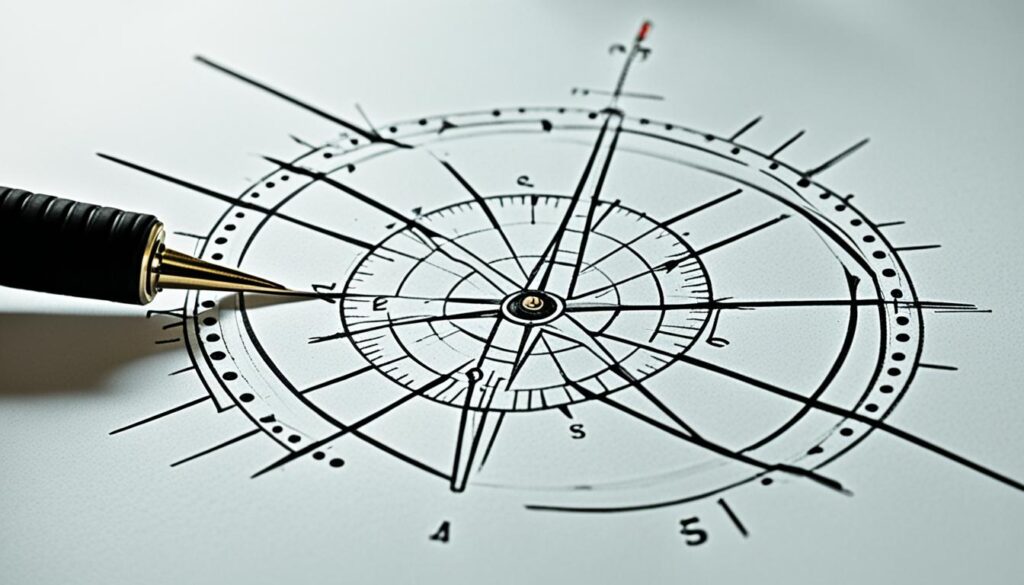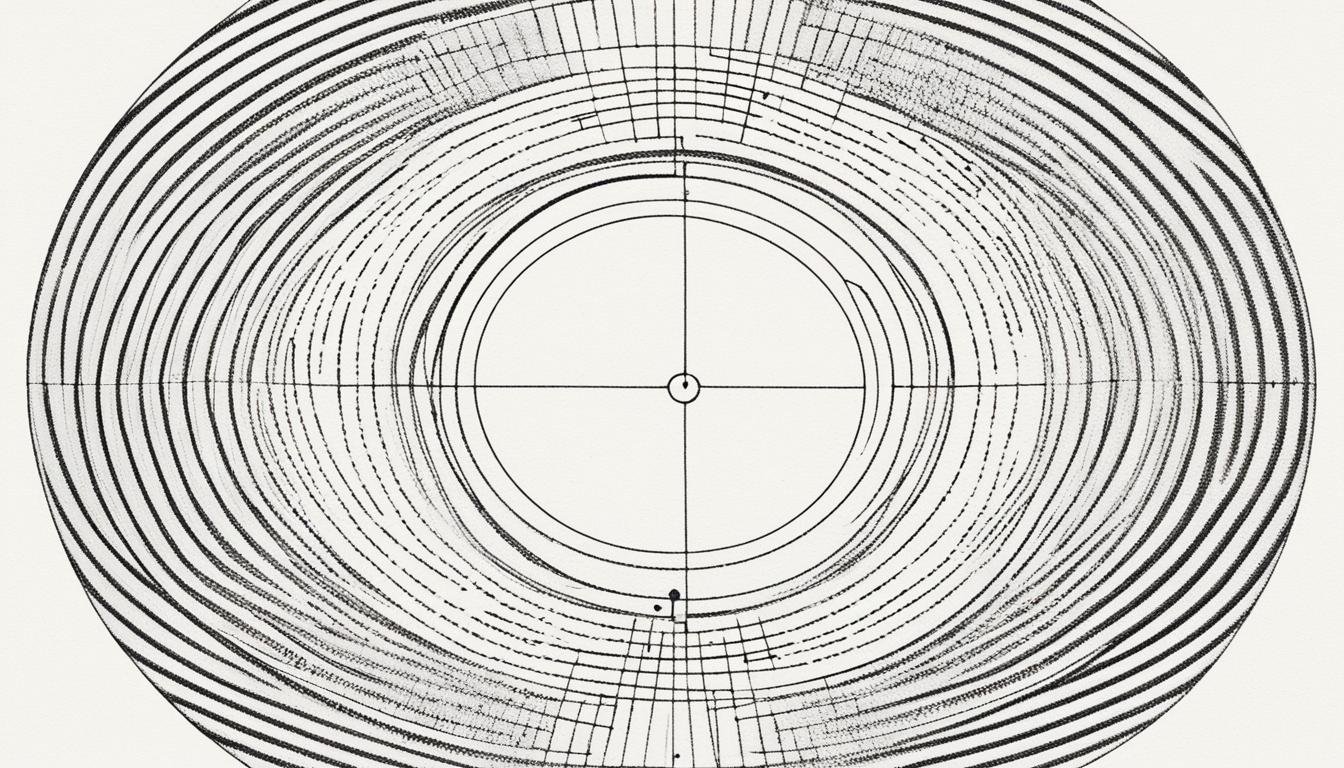Welcome to our comprehensive guide on the diameter of a circle! In this article, we will delve into the intricacies of this fundamental concept in circle geometry. Whether you’re a student, professional, or simply someone curious about the world of mathematics, understanding the diameter is essential.
So, what exactly is the diameter of a circle? Put simply, it is a line segment that passes through the center of a circle and connects two points on its circumference. The diameter is twice the length of the radius, another important property of a circle.
Calculating the diameter of a circle is a straightforward process. All you need is the radius, and you can use the formula: diameter = 2 * radius. It’s that simple! This formula allows us to determine the diameter based on the given information, making it an invaluable tool in geometry and mathematics.
Calculate with Ease: Distance Between Two Points Formula
The diameter plays a crucial role in various fields. Architects use it extensively for designing structures with precise dimensions, while engineers rely on it for constructing bridges, roads, and other infrastructure projects. Furthermore, physicists and astronomers utilize the diameter to measure celestial bodies, providing crucial insights into the vast universe around us.
Understand Isosceles Triangle Properties here!
Key Takeaways:
- The diameter of a circle is a line segment passing through its center, connecting two points on the circumference.
- The formula to calculate the diameter is diameter = 2 * radius, where the radius is half the length of the diameter.
- The diameter is widely used in various fields, such as architecture, engineering, and physics.
- Understanding the diameter is fundamental for geometry and mathematics.
- Stay tuned as we delve deeper into the intricacies of the diameter of a circle in the upcoming sections of this article.
What is the Diameter of a Circle?
In the fascinating world of geometry, understanding the properties of circles is essential. One of the key characteristics of a circle is its diameter. The diameter of a circle is defined as a line segment that passes through the center of the circle and connects two points on its circumference.
Did you know? The diameter is the longest chord in a circle, as it extends from one end to the other through the center.
The diameter plays a crucial role in determining other important aspects of a circle, such as its radius and circumference. In fact, the diameter is precisely twice the length of the radius, which makes it a fundamental component of circle geometry.
To calculate the diameter of a circle, we use a simple formula. By knowing the radius or the circumference of a circle, we can effortlessly determine its diameter.
Formula for Diameter Calculation
diameter = 2 * radius = circumference / π
The formula shows that the diameter is directly proportional to the radius. If we know the radius, we can easily find the diameter by multiplying it by 2. On the other hand, if we have the circumference, we can divide it by π (pi, approximately 3.14159) to calculate the diameter.
Let’s explore an example to illustrate the concept further:
| Given | Formula | Result |
|---|---|---|
| The radius of a circle | diameter = 2 * radius | 10 cm |
In the given example, we have a circle with a radius of 5 cm. By applying the formula for diameter calculation, we find that the diameter of the circle is 10 cm. Understanding the diameter is crucial as it allows us to explore various properties of circles and aids in solving geometric problems.
Calculating the Diameter of a Circle
Calculating the diameter of a circle is a straightforward process that involves using a simple formula. By knowing the circle’s radius or circumference, you can easily determine its diameter. Let’s explore the step-by-step instructions below:
Step 1: Understanding the Diameter
Before we dive into the calculation, let’s recap what the diameter of a circle actually represents. The diameter is defined as the straight line segment that passes through the center of the circle and connects two points on its circumference. It is twice the length of the radius and an essential metric in circle geometry.
Step 2: The Diameter Formula
In order to calculate the diameter of a circle, you need to use the following formula:
diameter = 2 * radius
Using this formula, you can find the diameter by doubling the value of the radius.
Step 3: Examples
Let’s walk through a couple of examples to illustrate how the diameter calculation works:
Example 1:
Suppose we have a circle with a radius of 5 cm. To find the diameter, we can use the formula:
diameter = 2 * radius = 2 * 5 = 10 cm
Therefore, the diameter of the circle is 10 cm.
Example 2:
Now, let’s consider a circle with a circumference of 20 m. We can use the circumference formula to find the radius first:
circumference = 2 * π * radius
Solving this equation for the radius, we get:
radius = circumference / (2 * π) = 20 / (2 * 3.14) ≈ 3.18 m
Once we have the radius, we can calculate the diameter using the formula:
diameter = 2 * radius = 2 * 3.18 ≈ 6.36 m

Summary
Calculating the diameter of a circle is essential for various mathematical and practical applications. By using the simple formula, diameter = 2 * radius, you can determine the diameter by doubling the value of the radius. Remember, the diameter is the straight line passing through the center and is twice the length of the radius. Armed with this knowledge, you can confidently calculate the diameter of any circle!
Diameter vs. Circumference
When discussing circles, two fundamental concepts often come up: diameter and circumference. While they may seem similar, they serve distinct purposes and have unique properties.
Diameter: The diameter of a circle is the distance across the circle passing through its center, and it is the longest chord in the circle. It is essentially twice the length of the radius. The diameter is a crucial measurement when it comes to understanding the size and proportions of a circle.
Circumference: The circumference of a circle, on the other hand, refers to the distance around the outer edge or boundary of the circle. It is the length of the curve that makes up the circle. The circumference is a valuable measurement, especially when determining the amount of material needed to enclose or cover a circular object.
Although diameter and circumference are related, they are not the same. Here’s a breakdown of their differences:
| Property | Diameter | Circumference |
|---|---|---|
| Definition | Distance across the center of a circle | Distance around the outer edge of a circle |
| Determining Formula | Diameter = 2 × Radius | Circumference = π × Diameter |
The relationship between diameter and circumference can be expressed using the mathematical constant π (pi), which is approximately 3.14159. This relationship is defined by the formula: Circumference = π × Diameter.
Understanding the difference between diameter and circumference is essential for various applications. Architects, engineers, and designers rely on these measurements to determine the dimensions of circular structures, while individuals working with circular objects need to calculate materials like wires or pipes accurately.
Now that we have established the dissimilarities between diameter and circumference, let’s move on to exploring their practical applications in the next section.
A Real-world Example:
“The diameter and circumference of a wheel are crucial factors when designing a bicycle. By accurately calculating the diameter, engineers can ensure a smooth ride with optimal balance and stability. On the other hand, the circumference helps determine how far the bicycle will travel with each rotation of the wheel.”
Practical Applications of the Diameternn
Now that we have a solid understanding of the concept of the diameter of a circle and how to calculate it, let’s explore some practical applications where this knowledge comes in handy. The ability to find the diameter of a circle can be extremely valuable in various fields, including architecture, engineering, and physics.
Architecturenn
In architecture, the diameter of a circle plays a crucial role in designing structures with circular elements. For example, when designing round windows or circular rooms, architects need to know the diameter of the circle to ensure proper proportions and aesthetic appeal. The diameter helps determine the size and placement of these circular features, resulting in visually pleasing architectural designs.
Engineeringnn
In the field of engineering, the diameter of a circle finds application in numerous areas. For instance, when designing gears or pulleys, engineers rely on the diameter to ensure proper meshing or rotation. The knowledge of the diameter also comes into play when calculating the torque and speed in mechanical systems. By accurately finding the diameter of circular components, engineers can create efficient designs and optimize the performance of various mechanisms.
Physicsnn
Understanding the diameter of a circle is essential in physics, particularly when dealing with rotational motion and angular velocity. When analyzing the motion of objects rotating around a fixed axis, physicists need to know the diameter of the circular path followed by these objects. This information helps in determining their speed and acceleration, as well as predicting their behavior under different conditions.
Figure: A practical application demonstrating the concept of finding the diameter of a circle in real-world scenarios.
As illustrated in the figure above, the diameter is a fundamental measurement that allows us to understand and work with circular shapes more effectively. By applying this knowledge in architecture, engineering, and physics, professionals in these fields can optimize their designs and calculations, leading to improved outcomes and solutions.
“The diameter is like a key that unlocks the potential of circles in various domains. By finding the diameter, we can harness the power of circles in architecture, engineering, and physics.” – [Name], [Title]Whether it’s designing a circular structure, calculating the size of rotating components, or analyzing the motion of objects, the diameter of a circle proves to be a vital piece of information. Its applications extend far beyond the realm of geometry, showcasing its importance and relevance in diverse fields of study and practice. By mastering the concept of the diameter, professionals can unlock countless possibilities and achieve greater success in their respective domains.
Conclusion
In conclusion, understanding the diameter of a circle is crucial in the study of circle geometry. The diameter is defined as the longest line segment that can be drawn within a circle, passing through the center and connecting two points on the circumference. It is an essential property that helps us calculate various aspects of circles and their measurements.
To calculate the diameter of a circle, we use a simple formula: diameter = 2 * radius. By knowing the diameter, we can determine the radius, circumference, and area of a circle, allowing us to solve a wide range of mathematical problems and practical applications.
The diameter of a circle also holds significance in real-world scenarios. Architects and engineers often rely on diameter calculations to design structures with precise measurements. Physicists utilize the diameter to understand the behavior of circular objects in motion. Whether it’s constructing buildings or studying celestial bodies, comprehending the diameter of a circle is essential for accurate calculations and problem-solving.
In conclusion, mastering the concept of the diameter of a circle empowers us to explore the intricate world of circle geometry and apply our knowledge in various fields. By understanding how to calculate the diameter and its role in different contexts, we unlock the potential to solve complex mathematical problems and make practical contributions to our world.
FAQ
What is the diameter of a circle?
The diameter of a circle is a straight line segment that passes through the center of the circle and connects two points on its circumference. It is the longest possible chord in a circle.
How is the diameter of a circle calculated?
The diameter of a circle can be calculated using the formula: diameter = 2 * radius. The radius is the distance from the center of the circle to any point on its circumference.
What is the relationship between the diameter and other properties of a circle?
The diameter is related to the radius, circumference, and area of a circle. It is twice the length of the radius, and the circumference can be calculated using the formula: circumference = π * diameter. The area of a circle can be calculated using the formula: area = π * radius^2.
How do I calculate the diameter of a circle?
To calculate the diameter of a circle, you can follow these steps:1. Measure the radius of the circle.2. Multiply the radius by 2 to find the diameter.For example, if the radius is 5 units, the diameter would be 2 * 5 = 10 units.
What is the difference between diameter and circumference?
The diameter of a circle is a straight line segment that passes through the center, whereas the circumference is the distance around the outer edge of the circle. The diameter is twice the length of the radius, while the circumference is calculated using the formula: circumference = π * diameter.
In what practical applications is knowledge of the diameter important?
Understanding the diameter of a circle is important in various real-world applications. For example, in architecture, the diameter of a circular window can determine the amount of light entering a room. In engineering, knowledge of the diameter is crucial for designing pipes, tunnels, and roundabouts. In physics, the diameter is used to calculate the moment of inertia for rotating objects.










